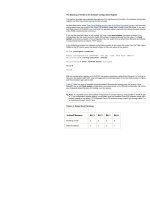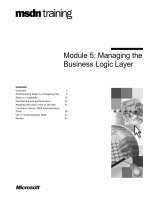Tài liệu CAMPUS DESIGN: ANALYZING THE IMPACT OF EMERGING ppt
Bạn đang xem bản rút gọn của tài liệu. Xem và tải ngay bản đầy đủ của tài liệu tại đây (2.6 MB, 91 trang )
CAMPUS DESIGN: ANALYZING THE
IMPACT OF EMERGING
TECHNOLOGIES ON CAMPUS DESIGN
SESSION RST-3479
RST-3479
11221_05_2005_c2
© 2005 Cisco Systems, Inc. All rights reserved.
1
Campus Design
A Multitude of Design Options and Challenges
• Campus network design is evolving in response
to multiple drivers
• Voice, financial systems driving requirement for
5 nines availability and minimal
convergence times
• Adoption of Advanced Technologies (voice,
segmentation, security, wireless) all introduce
specific requirements and changes
Si
Si
Si
Si
Si
Si
Si
Si
• The Campus is an integrated system everything
impacts everything else
Si
Si
Si
Si
High Availability Combined
with Flexibility and Reduced OPEX
RST-3479
11221_05_2005_c2
© 2005 Cisco Systems, Inc. All rights reserved.
2
Agenda
• Foundational Design Review
• Convergence—IP
Communications
• Wireless LAN and Wireless
Mobility
• High Availability
Alternatives to STP
Device HA (NSF/SSO and
Stackwise™)
Resilient Network Design
• Segmentation and
Virtualization
Access Control (IBNS and NAC)
Segmentation
ã Questions and Answers
RST-3479
11221_05_2005_c2
â 2005 Cisco Systems, Inc. All rights reserved.
3
Multilayer Campus Design
Hierarchical Building Blocks
Access
Distribution
Core
• Network trust boundary
• Use Rapid PVST+ if you MUST have L2 loops in
your topology
• Use UDLD to protect against 1 way up/up
connections
• Avoid daisy chaining access switches
• Avoid asymmetric routing and unicast flooding,
don’t span VLANS across the access layer
• Aggregation and policy enforcement
• Use HSRP or GLBP for default gateway protection
• Use Rapid PVST+ if you MUST have L2 loops in
your topology
• Keep your redundancy simple; deterministic
behavior = Understanding failure scenarios and
why each link is needed
Distribution
Access
RST-3479
11221_05_2005_c2
• Highly available and fast—always on
• Deploy QoS end-to-end: Protect the good and
Punish the bad
• Equal cost core links provide for best
convergence
ã Optimize CEF for best utilization of redundant
L3 paths
â 2005 Cisco Systems, Inc. All rights reserved.
Si
Si
Si
Si
Si
Si
Si
Si
Si
Si
Si
Si
4
Distribution Building Block
Reference Design—No VLANs Span Access Layer
• Unique Voice and Data
VLAN in every access
switch
• STP root and HSRP
primary tuning or GLBP
to load balance on
uplinks
• Set Port Host on access
layer ports:
Disable Trunking
Disable Etherchannel
Enable PortFast
• Configure Spanning Tree
Toolkit
Loopguard
Rootguard
BPDU-Guard
Layer 3
Si
VLAN 20 Data
10.1.20.0/24
VLAN 120 Voice
10.1.120.0/24
P-t-P Link
Si
VLAN 40 Data
10.1.40.0/24
VLAN 140 Voice
10.1.140.0/24
Distribution
Access
ã Use Ciscođ Integrated
Security Features (CISF)
Features
RST-3479
11221_05_2005_c2
© 2005 Cisco Systems, Inc. All rights reserved.
5
Campus Solution Test Bed
Verified Design Recommendations
Total of 68 Access Switches,
2950, 2970, 3550, 3560, 3750,
4507 SupII+, 4507SupIV, 6500
Sup2, 6500 Sup32, 6500 Sup720
and 40 APs (1200)
Three Distribution Blocks
6500 with Redundant Sup720
Si
Si
Si
Si
Si
Si
4507 with Redundant SupV
6500 with Redundant Sup720s
Si
Three Distribution Blocks
6500 with Redundant Sup720s
Si
Si
Si
Si
Si
Si
Si
7206VXR NPEG1
4500 SupII+, 6500 Sup720,
FWSM, WLSM, IDSM2, MWAM
WAN
RST-3479
11221_05_2005_c2
© 2005 Cisco Systems, Inc. All rights reserved.
Data Center
Internet
6
Agenda
• Foundational Design Review
• Convergence—IP
Communications
• Wireless LAN and Wireless
Mobility
• High Availability
Alternatives to STP
Device HA (NSF/SSO and
Stackwise)
Resilient Network Design
• Segmentation and
Virtualization
Access Control (IBNS and NAC)
Segmentation
ã Questions and Answers
RST-3479
11221_05_2005_c2
â 2005 Cisco Systems, Inc. All rights reserved.
7
Building a Converged Campus Network
Infrastructure Integration, QoS and Availability
• Access layer
Auto phone
detection
Access
Inline power
QoS: scheduling,
trust boundary and
classification
Si
Distribution
Si
Si
Si
Si
Si
Fast convergence
• Distribution layer
High availability,
redundancy, fast
convergence
Core
Policy enforcement
QoS: scheduling,
trust boundary and
classification
Distribution
Layer 3
Equal Cost
Links
Si
Si
• Core
Si
Si
High availability,
redundancy, fast
convergence
QoS: scheduling,
trust boundary
RST-3479
11221_05_2005_c2
Si
Si
Layer 3
Equal Cost
Links
Si
Si
Access
© 2005 Cisco Systems, Inc. All rights reserved.
WAN
Data Center
Internet
8
Infrastructure Integration
Extending the Network Edge
Switch Detects IP Phone and Applies Power
CDP Transaction Between Phone and Switch
IP Phone Placed in Proper VLAN
DHCP Request and Call Manager Registration
•
Phone contains a 3 port switch that is configured in
conjunction with the access switch and CallManager
1. Power negotiation
2. VLAN configuration
3. 802.1x interoperation
4. QoS configuration
5. DHCP and CallManager registration
RST-3479
11221_05_2005_c2
© 2005 Cisco Systems, Inc. All rights reserved.
9
Infrastructure Integration: First Step
Device Detection
Pre-Standard Switch Port
Pre-Standard PoE Device (PD)
Pin3
FLP
TX
Pin2
IEEE 802.3af PSE
-2.8V to -10V
© 2005 Cisco Systems, Inc. All rights reserved.
TX
IEEE 802.3af PD
Pin3
Detect Voltage Pin6
It’s an
RX
IEEE PD
RST-3479
11221_05_2005_c2
FLP
Pin1
It’s an Inline RX
Device
TX
RX
Pin6
Cisco Pre-Standard
Uses a Relay in PD
to Reflect a Special
FastLink Pulse to
Detect Device
25K Ohm
Resistor
RX
Pin1
Pin2
TX
802.3af Applies a
Voltage in the Range
of -2.8V to -10V on
the Cable and Then
Looks for a 25K
Ohm Signature
Resistor
10
Infrastructure Integration: First Step
Power Requirement Negotiation
• Cisco pre-standard devices initially receive 6.3 watts and then
optionally negotiate via CDP
• 802.3af devices initially receive 12.95 watts unless PSE able to
detect specific PD power classification
Class
Usage
Minimum Power
Levels Output at the
PSE
0
Default
15.4W
0.44 to 12.95W
1
Optional
4.0W
0.44 to 3.84W
2
Optional
7.0W
3.84 to 6.49W
3
Optional
15.4W
6.49 to 12.95W
4
Reserved
for Future
Use
Treat as Class 0
Reserved for Future Use: a Class 4
Signature Cannot Be Provided by a
Compliant Powered Device
RST-3479
11221_05_2005_c2
© 2005 Cisco Systems, Inc. All rights reserved.
Maximum Power Levels at the
Powered Device
11
Enhanced Power Negotiation
802.3af Plus Bi-Directional CDP (Cisco 7970)
PSE—Power
Source Equipment
Cisco 6500,4500,
3750, 3560
PD Plugged in
Switch Detects IEEE PD
PD Is Classified
Power Is Applied
Phone Transmits a CDP Power Negotiation
Packet Listing Its Power Mode
Switch Sends a CDP Response with a
Power Request
PD—Powered
Device Cisco 7970
Based on Capabilities Exchanged
Final Power Allocation Is Determined
• Using bidirectional CDP exchange exact power requirements
are negotiated after initial power-on
RST-3479
11221_05_2005_c2
© 2005 Cisco Systems, Inc. All rights reserved.
12
Design Considerations for PoE
Power Management
• Switch manages power by what is allocated not by what is
currently used
• Device power consumption is not constant
• A 7960G requires 7W when the phone is ringing at maximum
volume and requires 5W on or off hook
• Understand the power behaviour of your PoE devices
• Utilize static power configuration with caution
Dynamic allocation:
power inline auto max 7200
Static allocation:
power inline static max 7200
• Use power calculator to determine power requirements
/>RST-3479
11221_05_2005_c2
© 2005 Cisco Systems, Inc. All rights reserved.
13
Infrastructure Integration: Next Steps
VLAN, QoS and 802.1x Configuration
Phone VLAN = 110
(VVID)
802.1Q encapsulation
with 802.1p Layer 2
CoS
PC VLAN = 10
(PVID)
Native VLAN (PVID) No
Configuration Changes
Needed on PC
• During initial CDP exchange phone is configured with a Voice
VLAN ID (VVID)
• Phone also supplied with QoS configuration via CDP
TLV fields
• Additionally switch port currently bypasses 802.1x
authentication for VVID if detects Cisco phone
RST-3479
11221_05_2005_c2
© 2005 Cisco Systems, Inc. All rights reserved.
14
Why QoS in the Campus
Protect the Good and Punish the Bad
• QoS does more than just protect Voice and Video
• For "best-effort" traffic an implied "good faith" commitment that
there are at least some network resources available is assumed
• Need to identify and potentially punish out of profile traffic
(potential worms, DDOS, etc.)
ã Scavenger class is an Internet-2 Draft Specification => CS1/CoS1
Access
Distribution
Voice
Voice
Data
Data
Scavenger
RST-3479
11221_05_2005_c2
Core
Scavenger
â 2005 Cisco Systems, Inc. All rights reserved.
15
Campus QoS Design Considerations
Classification and Scheduling in the Campus
Classify
• Edge traffic classification
scheme is mapped to
upstream queue
configuration
Si
• Voice needs to be
assigned to the HW
priority queue
Scavenger
Queue
Aggressive Drop
Gold
RX
• Scavenger traffic needs
to be assigned its own
queue/threshold
Data
• Scavenger configured
with low threshold to
trigger aggressive drops
Scavenger
RX
• Multiple queues are the
only way to “guarantee”
voice quality, protect
mission critical and
throttle abnormal sources
RST-3479
11221_05_2005_c2
Throttle
© 2005 Cisco Systems, Inc. All rights reserved.
RX
Si
TX
Voice
RX
Voice Put into
Delay/Drop
Sensitive Queue
16
Agenda
• Foundational Design Review
• Convergence—IP
Communications
• Wireless LAN and Wireless
Mobility
• High Availability
Alternatives to STP
Device HA (NSF/SSO and
Stackwise)
Resilient Network Design
• Segmentation and
Virtualization
Access Control (IBNS and NAC)
Segmentation
ã Questions and Answers
RST-3479
11221_05_2005_c2
â 2005 Cisco Systems, Inc. All rights reserved.
17
Wireless Integration into the Campus
Non-Controller-Based Wireless
Layer 3
Layer 2
Voice Data
•
Use a 802.1Q trunk for
switch to AP connection
•
Different WLAN
authentication/encryption
methods require
new/distinct VLANs
•
Layer-2 roaming requires
spanning at least 2 VLANs
between wiring closet
switches
Voice Data
Wireless
VLANs
Fast Roam Using L2
1. Common ‘Trunk’ or native
VLAN for APs to
communicate to WDS
2. The Wireless Voice VLAN
RST-3479
11221_05_2005_c2
© 2005 Cisco Systems, Inc. All rights reserved.
18
Controller-Based WLAN
The Architectural Shift
WLSM/WDS
Controller
• Wireless LAN Switching
Module (WLSM) provides a
virtualized centralized Layer
2 domain for each WLAN
Layer 3
Voice Data Wireless Voice Data
VLANs
• Cisco wireless controller
provides for a centralized
point to bridge all traffic into
the Campus
• AP VLANs are local to the
access switch
• No longer a need to span a
VLAN between closets
• No spanning tree loops
Fast Roam with No STP
RST-3479
11221_05_2005_c2
© 2005 Cisco Systems, Inc. All rights reserved.
19
Wireless LAN Switching Module (WLSM)
Traffic Flows
Si
Traffic
Routed
• All traffic from mobile user 1 to
mobile user 2 will traverse the
GRE tunnel to the Sup720
• Sup720 forwards deencapsulated packets in HW
• The packet is switched and sent
back to the GRE tunnel
connected to other AP
• When mobile nodes associate
to the same AP traffic still flows
via the WSLM/Sup720
• Broadcast traffic either proxied
by AP (ARPs) or forwarded to
Sup720 (DHCP)
• Traffic to non-APs is routed to
the rest of the network
RST-3479
11221_05_2005_c2
© 2005 Cisco Systems, Inc. All rights reserved.
20









